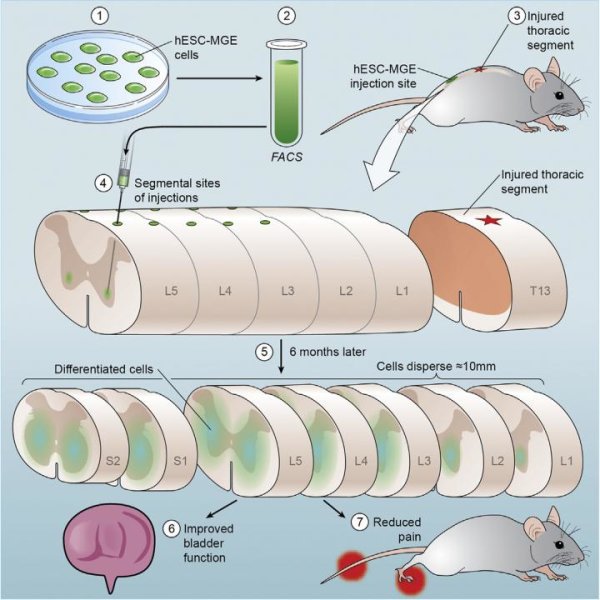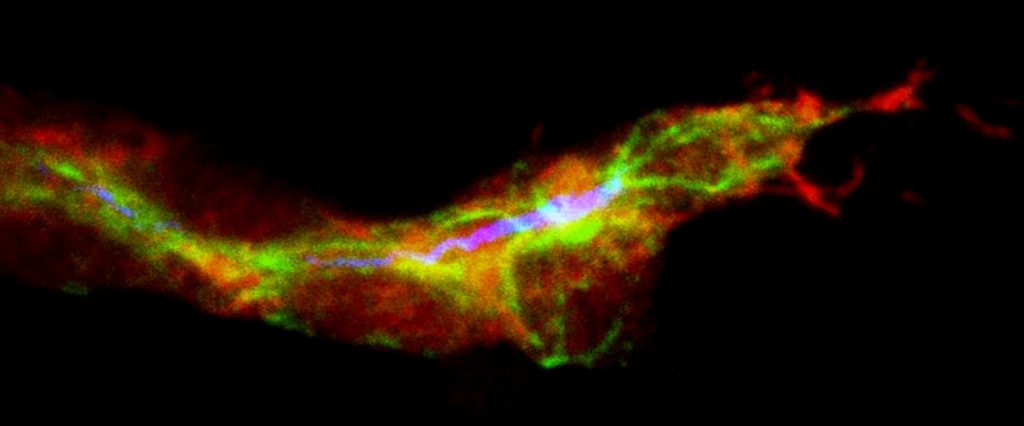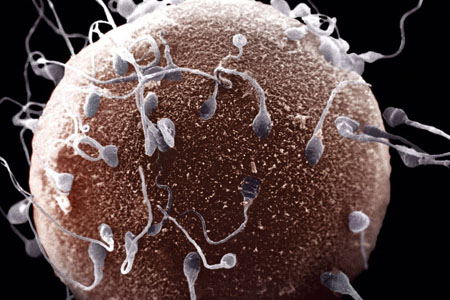People with spinal cord injuries suffer from many complications in addition to paralysis and numbness. Some of these problems are caused by a lack of the neurotransmitter GABA in the injured spinal cord. Now research in mice is showing that human embryonic stem cells differentiated into medial ganglionic eminence (MGE)-like cells, which produce GABA, may help alleviate two of the most severe side effects — chronic neuropathic pain and bladder dysfunction. The results appear September 22 in Cell Stem Cell.

Credit: Fandel et al./Cell Stem Cell 2016
This study, a collaboration between senior authors Arnold Kriegstein, Director of the Developmental and Stem Cell Biology Program at the University of California, San Francisco (UCSF), and Linda Noble-Haeusslein, a professor in the Departments of Neurological Surgery and Physical Therapy and Rehabilitation Science at UCSF, addressed both neuropathic pain and bladder dysfunction, which are at least in part attributed to overactive spinal cord circuits. “We reasoned if we could take inhibitory neurons and directly place them into the spinal cord in the regions that are overactive, they might integrate into those circuits and suppress the activity,” says Kriegstein.
GABA (gamma-Aminobutyric acid) is an inhibitory neurotransmitter that is found throughout the central nervous system. It plays an important role in reducing the excitability of neurons by binding to receptors that act on synapses. In the study, the investigators used GABAergic inhibitory neuron precursors called MGE-like cells that were derived from human embryonic stem cells.
The neural precursor cells were placed into the spinal cords of mice two weeks after injury had been induced, where they could differentiate into GABA-producing neuron subtypes and form synaptic connections.
“Rather than implanting these cells into the site of injury, at the mid-thoracic level, we injected them in the lumbosacral region, where the circuits are known to be overactive,” says Thomas Fandel, a research specialist at UCSF and the study’s co-first author. “Six months later we could see broad dispersion of the cells in that area. They were integrated into the spinal cord.”
The researchers used several measures to determine whether the stem cells were effective in alleviating neuropathic pain and bladder dysfunction at six months. To assess for bladder control, the mice were placed in cages with filter paper that showed where the mice had urinated. The treated mice had fewer, larger spots, indicating less leakage. Bladder function was also assessed by measuring bladder volume and tension, which confirmed the improved voiding ability of animals receiving transplants.
By six months after transplant, animals exhibited significantly reduced pain sensitivities. Grooming and scratching behaviors were also evaluated, as decreased GABA in the spinal cord can similarly cause pathological itch (pruritus). The researchers found that mice receiving the stem cell transplants showed decreased overgrooming compared to controls.
“The fact that these cells were implanted in the spinal cords two weeks after injury is also important to note,” says Alpa Trivedi, a researcher at UCSF and co-first author of the study. “Many of the current Phase I trials for spinal cord injury are run in the acute phase, which is right after injury. But the vast majority of people with spinal cord injuries are the chronic patient population, and a treatment that might work for them would capture a larger number of patients who are really in need of better treatments.”
Current treatments for neuropathic pain in people with spinal cord injuries most often involve opioids and other pain medications, as well as certain antidepressants, which have many side effects and tend to have limited efficacy. Treatments for bladder dysfunction are often anticholinergics, but these drugs have side effects like dizziness and dry mouth. Botulinum toxin (Botox®) may help with bladder spasms, but the benefits tend to be transient. “The current approaches for treatment are not very effective and clearly more options are needed,” Dr. Fandel says. “Our hope is that this treatment would last a long time, or maybe even be permanent.”
Additional research is needed before the stem cells can be tested in patients, but the researchers have already taken the first step by using human-derived stem cells rather than mouse stem cells in their animal models. “Chronic pain and bladder dysfunction remain significant quality-of-life issues for many people with spinal cord injuries. Inhibitory cell-based neuro-therapy is a new approach and has shown promise to date in early animal studies, warranting further development,” says Cory Nicholas, a co-first author.
Web Source: Cell Press.
Journal Reference:
Thomas M. Fandel, Alpa Trivedi, Cory R. Nicholas, Haoqian Zhang, Jiadong Chen, Aida F. Martinez, Linda J. Noble-Haeusslein, Arnold R. Kriegstein. Transplanted Human Stem Cell-Derived Interneuron Precursors Mitigate Mouse Bladder Dysfunction and Central Neuropathic Pain after Spinal Cord Injury. Cell Stem Cell, 2016; DOI: 10.1016/j.stem.2016.08.020
The post Human stem cells treat spinal cord injury side effects in mice appeared first on Scienmag.





